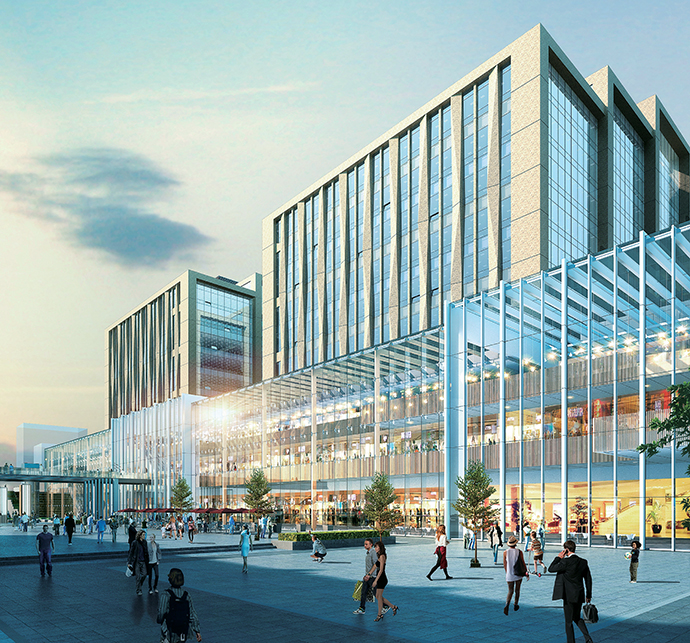If you don’t yet know industrial city developer and operator China Fortune Land Development (CFLD), you’re about to. And it’s not just because the company employs more than 5,100 people, is the No. 1 Chinese real estate firm or has assets worth the equivalent of US$25 billion that have helped support the creation of more than 14,000 jobs.
You might even see the CFLD name at sports venues before you see it on a building. That’s because the organization does things like sponsor the annual Beijing Marathon and compete in soccer’s Chinese Super League with its Hebei China Fortune team, with visions of competing with the world’s soccer elite.
Global competitiveness is what CFLD is all about, the essence of its mission not only in China but around the world. Launched in 1998, CFLD is governed by four key commitments in the development of new industrial cities following a public-private partnership model: green development, urban quality of life, continuous innovation and drawing industries together into clusters.
CFLD’s strategy calls for developments in the regional economic zone of Beijing-Tianjin-Hebei, the Yangtze River, the Pearl River Delta and in concert with the advanced planning of China’s “One Belt, One Road” initiative. In early 2015, in advance of the October 2015 release of China’s 13th five-year plan, the People’s Republic released a “One Belt, One Road” vision document for its trillion-dollar transport plan, steeped in Silk Road and “maritime silk road” historical precedent going back to the Han dynasty two millennia ago. The vision for this giant global infrastructure loop aims to “uphold the global free trade regime and the open world economy in the spirit of open regional cooperation,” and is backed by the Chinese government’s $40-billion Silk Road Fund, as well as $50 billion from the Asian Infrastructure Investment Bank.
Industrial Cities, Innovation Neighborhoods
That sounds a lot like CFLD’s own vision. The company is now represented in over 40 regions around the world, and its parks are host to more than 1,100 blue-chip companies. The goal? More than 100 developments that are more than industrial parks — they’re new industrial cities.
Each CFLD industrial city is designed around a particular cluster. The Shenshui Eco-Technology Innovation City (SEIC), for instance, is CFLD’s first new industrial city in Shenyang, focused on the automotive, advanced manufacturing and equipment, and health food sectors.The new industrial city in Jiashan County, Zhejiang Province, has a goal of developing a new high-speed-rail-connected city, with a cluster focus on the Internet, cultural production and intelligent manufacturing.
CFLD also is working with TechCode to place business incubators and accelerators in strategic global locations: Beijing (2), Shanghai, Shenzhen, Jiashan, Xianghe, Nanjing and Gu’an in China; Silicon Valley; Seoul; Tel Aviv and Berlin. These dozen dens of discovery currently host nearly 170 companies that employ 2,500 people and are valued at around US$2.8 billion collectively.
Global Momentum
In the first half of 2016, CFLD showed a net profit growth rate of more than 30 percent, to the equivalent of $583 million. Some highlights:
- The company’s well known industrial cities across the Beijing and Nanjing regions continue to do well, but second-tier projects also continue to roll. “Tier-2 parks like Sujiatun, Huailai, Bazhou, Jiashan, Xianghe and Yongqing have rapidly risen,” says CFLD.
- The company signed an agreement with AS, the flagship company of the Argo Manunggal Group of Indonesia. This has resulted in the formal agreement to build Indonesia’s first international new industrial city.
- CFLD also won the bid for the Langfang-Zhuozhou-Gu’an-Baoding inter-city railway project as a social investor in mid-May, becoming the first private company to invest in and hold shares of an inter-city passenger railway project.
- CFLD has collaborated with Fortune 500 companies and industrial leaders such as Voestalpine, Kunshan Govisionox Optoelectronics Co., BOE, Faurecia and Jinhaian Industry to drive the clustering of upstream and downstream companies in the industrial supply chain.
- The company has agreed to cooperation with universities and research institutes such as Tsinghua University and Korea’s Chungnam National University.
- In June 2016, CFLD International officially opened in Singapore, calling it “a major breakthrough in the company’s global strategy.”
- In July 2016, CFLD India signed an MOU with the State Government of Haryana in India and HSIIDC to collaborate on a major new industrial city. In September, it signed a similar MOU with the State Government of Maharashtra and The City & Industrial Development Corporation (CIDCO) centered in Navi Mumbai International Airport Influence Notified Area (NAINA), where a new industrial city is proposed to be on 600 hectares (nearly 1,500 acres).
- Also in September, CFLD Vietnam signed an MOU with the Tin Nghia Corporation of Vietnam to build a New Industrial City (NIC) in Saigon East New City’s Ong Keo Industrial Park.
Sometimes the visions of CFLD and China align well with equally ambitious visions abroad. In October, CFLD was awarded the contract to build a new industrial city in Egypt’s new administrative capital between Cairo and Suez. China has become Egypt’s largest trade partner.
In January 2016, Chinese President Xi Jinping met with Egyptian President Abdel Fattah al-Sisi, with both sides signing bilateral cooperation agreements in areas such as energy, infrastructural construction, economic trade, energy, finance and aerospace. A series of major national strategic projects mirroring China’s “One Belt, One Road” initiative was also launched in Egypt, attracting a growing number of Chinese enterprises.
For more information about China Fortune Land Development, visit en.cfldcn.com.

